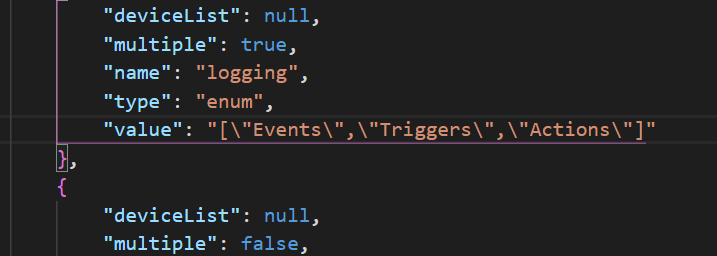Being able to export all rules in one location makes it very quick to export and backup all rules. Much simpler to back them up from the same interface. Great work @bravenel
Hub Mesh is super efficient, and you don't need to install any drivers -- works with any device.
That's neat -- including all the attributes ??
Please use with care for now. It is marked beta for a reason. Also, please be sure to have a good backup of your hub just in case it goes off the rails. If the parent app has a bug, it kills it. One user reported this, and the only way out is to restore from backup.
Yes, and custom commands.
And, no drivers!!
My brain short circuit
I just discovered that I can export rules but there seems to be a problem with the JSON (according to Visual Studio Code
Manually corrected to
There should only be a single \ in the JSON. As it is written the inner quotes are not escaped. As an aside, it is supposed to be an array why make it a string. As in

More as I learn. My goal is to be able to create and edit rules use external tool and import them. Even better if I can use the MakerAPI to import them. At this point I'm just begging to understand how it works.
It's not our intent that these be editable, nor to provide a means to create rules through creating a JSON file. Your editor is misleading you. So the comments about the JSON formatting are not really right. If you want whatever rule that came from to work, it would of necessity be formatted that way.
I'm afraid that it would take a great deal of effort to reverse engineer RM this way, and there would be no reason to think that its internals might not change at any time.
Looking at the title of this topic, we undertook to provide a means to save, clone and restore rules, but not the 'cooking recipe' part.
I can accept the no-manipulating, but it's still useful to be able to look at it. I appreciate the use of JSON and would like to see it for all backups. I'm not sure what you mean by "editor is misleading you" since JSON is well-defined (even if overly strict).
That said, I would like to be able to edit and load a text version of the rules since having to enter and update the rules manually doesn't scale.
I'm guessing the JSON goes through a previous interpretation step prior to loading it as JSON, which would require the backslashes to be backslashed, otherwise they would get removed. As such, the JSON output is not true JSON, it's an escaped version that will result in a JSON once processed.
In other words, you would have to figure out/reverse engineer how that all works to create a proper file, usable by HE. As @bravenel said, probably not a good use of time, especially considering they may change it anyway.
I understand how it happens. I can work around it but if I simply want to look at it in, say, VSC, then the lack of escaping is one more annoyance.
(Speaking of which, where do I find documentation on what the URL encode setting does?)
My larger issue is that if I have 10 Hue switches with 4 buttons and each with 4 states I get into a challenge in making the settings. This is why I want to be able to build tools to edit the scripts rather than going through the menus again and again, and then repeating it for a change.
If there is a way, please tell me.
It seems you’re going pretty far down a rabbit hole in an effort to do something that may not even work?
There is not, other than just writing your own groovy app - which seems like it would fit your needs much better actually.
If your comfortable enough to use VSC/code then just make your own apps...
If there were better debugging tools and documentation for Groovy I would do it. But the more I can leverage what there is the better.
This is why I really want JavaScript/TypeScript support but I don't see that happening.
Another possibility is using the Maker API but, again, more moving parts.
There are perfectly adequate debugging tools and documentation for Groovy. All of the built-in apps and drivers, and all of the community apps and drivers have been implemented on hubs. Debugging is done with log.debug in the code as needed, to come out later...
For documentation on Groovy, Google is an excellent resource -- I use it all the time if I need to know/remember something I don't know. Online documentation for Groovy is extensive and on point.
It's not hard to write a special purpose app that implements some chosen subset of RM. It's also possible to use RM for actions, with custom app to cause them to happen through the documented RM API.
There are example apps in our public GitHub repo, that show the basic framework for an app on the hub.
Maker api doesn't help you with what you are trying to do with either though.
Unless he wants to go down the Node Red rabbit hole. 





